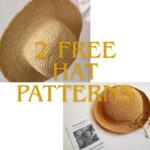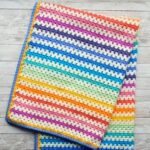Hello, everyone!
Today, we’re diving into one of the most important tools in the crochet world: the crochet hook. If you’ve ever found yourself wondering which hook is best for your projects, you’re not alone—and this article is here to help.
In a previous post, we explored different types of crochet threads and how yarn labels often recommend the ideal hook size. But the world of crochet hooks is just as diverse, with countless shapes, sizes, materials, and brands to choose from. Understanding the differences can help you make better, more confident choices for your projects.
Whether you’re new to crochet or looking to improve your technique, getting familiar with the various types of hooks is essential. The right hook can make your stitches more even, your hands more comfortable, and your finished work more beautiful. In this guide, we’ll walk through the different types of crochet hooks, explain how to hold them, and share helpful tips for beginners.
Anatomy of a Crochet Hook

Before we look at the different types of hooks, it helps to understand the parts of a crochet hook:
-
Head: The tip that catches the yarn.
-
Throat: The groove that guides the yarn through stitches.
-
Shaft: The part that determines stitch size.
-
Grip: Where your fingers rest for control.
-
Handle: The end of the hook, often designed for comfort.
Knowing these parts makes it easier to understand how different hooks work and what might suit your hand and style best.
Which Type of Crochet Hook is Right for You?
There are two main types of crochet hooks you’ll come across:
Inline Hooks
These hooks have a more pointed head that’s aligned with the shaft. The shaft is usually shorter, and the hook shape is more angular. Many crocheters prefer inline hooks because they help create uniform stitches and maintain consistent tension.
Tapered Hooks
Tapered hooks feature a rounded head, a narrower throat, and a longer shaft. They glide easily into stitches, which can be especially helpful for beginners or when working on more detailed patterns.
So, which should you choose?
That’s entirely up to you! Most crocheters develop a preference based on what they first learned with or what feels more natural in their hands. If you’re not sure which style you prefer, try both and see what works best for your projects.

How to Hold a Crochet Hook
Just like with writing or drawing, there’s more than one way to hold a crochet hook. The two most common grips are:
-
Pencil Grip: Hold the hook like a pencil, using your thumb and index finger in a pinch.
-
Knife Grip: Hold the hook like a knife, with your hand wrapped around the handle and your fingers guiding the motion.
As you gain experience, you might find one grip works better for certain projects or yarn types. There’s no “correct” way to hold a hook—just go with what feels comfortable and allows you to crochet with ease.


Types of Crochet Hooks
As we mentioned earlier, most yarn labels will suggest the recommended hook size for that particular yarn. However, some projects might require more than one hook size to achieve the right look, texture, or gauge. And while the size is important, there’s much more to a crochet hook than just its dimensions.
Let’s take a closer look at what makes crochet hooks different—and how to choose the right one for your needs.
Crochet Hook Sizes
Crochet hook sizes are usually measured in millimeters (mm), which is the standard used by most manufacturers around the world. Some brands may also use letters (like G/6 or H/8 in the US) or even custom numbering systems, but the millimeter size is the most accurate and universal reference.

Tip: Always check for the millimeter marking on your hook—it’s the best way to make sure you’re using the right size, no matter what brand or pattern you’re working with.
Crochet Hook Materials
Crochet hooks come in a wide range of materials and even fun colors. Each material offers a unique feel, grip, and weight that can impact your comfort and control. Here are some of the most common materials you’ll find:
-
Metal (Aluminum, Steel)
-
Plastic
-
Rubber (often used for ergonomic handles)
-
Bamboo (and other wood types)
Let’s explore some of the most popular types and their benefits:
Colored Aluminum Hooks
These lightweight hooks come in bright, vibrant colors—each color representing a different size (usually from 2mm to 10mm). Not only are they cheerful and easy to identify, but they also offer a smooth glide and quick stitching experience. Great for beginners and experienced crocheters alike!

Nickel-Plated Steel Hooks
Often used for working with fine thread or lace projects, these small-sized hooks (ranging from 0.6mm to 2.1mm) are sleek and durable. Their smooth surface helps you make delicate, precise stitches with ease.

🪝 Aluminum Hooks with Plastic Handles
These hooks are a favorite for many crocheters because of their ergonomic design. The plastic handle offers extra comfort and grip, especially during longer sessions. They may cost a little more, but your hands will thank you!

Double-Ended Steel Hooks
These hooks have two different sizes, one on each end—typically ranging from 2.0mm to 5.0mm. They’re often used for Tunisian crochet (also known as Afghan crochet), offering versatility and value in a single tool.

Aluminum Hooks with Bamboo Handles
If you love the feel of natural materials, bamboo-handled hooks offer a warm, lightweight alternative. The smooth bamboo grip paired with an aluminum head makes them great for textured yarns like Baroque. Stylish and functional!

A Note for Beginners: Why Hook Size Matters
If you’re new to crochet, it can sometimes be confusing to figure out which hook size to use. That’s why it’s helpful to keep a crochet hook conversion chart handy. Patterns from different countries use different size systems, and being able to translate between them can save time and frustration.
Whenever you’re unsure, just check the yarn label—it will typically tell you:
-
The yarn weight (e.g., lace, worsted, bulky)
-
The recommended hook size
-
Gauge info (how many stitches and rows create a 10″ x 10″ swatch)
Still, these are only suggestions—sometimes using a larger or smaller hook can help you achieve the texture or drape you’re going for.
What Size Crochet Hook Should You Use?
If you’re new to crochet and unsure which hook to start with, don’t worry—it’s easier than you think! The best place to look is the yarn label, which typically includes all the information you need.
Here’s what you’ll usually find on a yarn label:
-
Yarn Weight – This ranges from 0 (Lace) to 7 (Jumbo).
-
Recommended Hook Size – Often listed in both millimeters and US/UK sizes.
-
Gauge Information – This tells you how many stitches and rows should create a 10″ x 10″ square using single crochet.
By following these guidelines, you’ll be well on your way to selecting the perfect hook for your yarn and project.
Do You Have to Follow the Suggested Hook Size?
While the recommended hook size on the yarn label is a great starting point, it’s not a strict rule. There are times when adjusting the hook size can actually improve your results.
-
Using a slightly smaller hook can give your stitches more structure and create a firmer fabric—ideal for things like bags or amigurumi.
-
Using a larger hook, especially with jumbo yarn, will give you a soft, airy texture—great for cozy blankets or oversized scarves.
Experimentation is part of the fun. Don’t be afraid to test a few sizes to find what works best for your pattern and personal style.
Why a Crochet Hook Conversion Chart Is Helpful

Thanks to online patterns and tutorials, crocheting has become more accessible across the globe. But that also means you’ll encounter different sizing systems depending on where the pattern comes from.
-
In the US, hook sizes are often labeled with letters (like G/6 or H/8).
-
In the UK and internationally, sizes are listed in millimeters, which is the most consistent and reliable method.
To avoid confusion, it’s a good idea to keep a crochet hook conversion chart handy. It helps you easily match your existing hooks to patterns written in another system.
Common Hook Sizes for Beginners
Most beginner-friendly patterns use medium-weight yarns, so it’s smart to have these two hook sizes in your toolkit:
-
4mm (G/6)
-
5mm (H/8)
These are versatile sizes that work well for scarves, dishcloths, basic garments, and more. When in doubt, go with the millimeter size—it’s the most accurate and consistent across brands.

Watch and Learn: Crochet Hook Video Guide
Want a visual explanation? We’ve included a helpful video from the Naztazia Channel that walks you through the different types of crochet hooks, their uses, and tips for getting started. Don’t miss it—it’s full of great advice!
Final Thoughts
At the end of the day, choosing the right crochet hook comes down to personal preference and practice. The more you crochet, the more you’ll learn what works best for you—whether it’s a specific hook size, material, or grip style.
If you stumble upon a new or unusual crochet hook that isn’t mentioned here, feel free to share it—we love discovering new tools with fellow crafters.
Happy crocheting, and may every stitch bring you joy! 🧶



